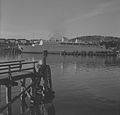Sassnitz (ship, 1959)

|
|
| Sassnitz | |
|---|---|
| Builder: | Neptun shipyard , Rostock |
| Keel laying: | October 21, 1957 |
| Launch: | July 12, 1958 |
| Commissioning: | June 22, 1959 |
| Routes: |
Saßnitz – Trelleborg route Ferry Sassnitz - Ronne |
| Technical specifications | |
| Tonnage : | 6164 BRT / 2318 NRT |
| Length: | 137.50 m |
| Width: | 18.80 m |
| Draft: | 5.3 m |
| Drive: | 4 diesel engines Halberstadt 9 SV 66 Au |
| Total output: | 7060 kW |
| Speed: | 18 knots |
| Passengers: | 1017 (after renovation 1400) |
| Cabin places: | 12 (after modification 428) |
| Vehicle capacity: | 40 freight wagons and 40 cars (after conversion 240 cars) |
| Track length: | 398 m |
| Loading meter freight: | after renovation 525 m |
| Crew: | 115 men |
The Sassnitz was a German railway ferry that operated for 27 years on the royal line between Saßnitz and Trelleborg and 11 years in the Mediterranean .
history

The Sassnitz was built in 1958/59 at the Neptun shipyard in Rostock . After delivery on June 22, 1959 to the Deutsche Reichsbahn , it was used on the Saßnitz-Trelleborg line. At times it also ran between Saßnitz and Rønne.
In 1986 the Sassnitz was sold to the subsidiary Afroessa Lines of the Greek shipping company Arkadia Lines and renamed Silver Paloma . After a renovation, it operated on the Piraeus - Rhodes - Limassol - Haifa line until 1993 . In 1994 it was used on the Igoumenitsa - Bari line. From 1995 she drove on the same route as Megistanas under the Maltese flag . In 1997, she was in Eleusis launched . In 2000 the ship was scrapped in Alang, India .
properties
The Sassnitz was the last ship with a partially riveted outer skin that was built at the Neptun shipyard. It was 137.5 meters long, 18.8 meters wide and had a side height of 7.5 meters up to the car deck. The full-decker was measured with 6164 GRT and 2318 NRT , the displacement was 6974 tons, the load capacity 1843 tons. The draft was 5.3 meters.
The Sassnitz was powered by four reversible, supercharged four-stroke diesel engines with a total of 9600 hp. These worked in pairs on two screws. The speed was 18 knots. A bow rudder and a bow thruster with a rotary control cylinder, which was new at the time of construction, improved the maneuverability when moving slowly and in reverse.
40 freight cars or 16 express train cars could be transported on the four-track wagon deck with a track length of 398 meters . There was also space on board for 40 cars and 1017 passengers. The crew consisted of 115 people.
The passengers were accommodated in salons during the journey. The captain had a reception room, a study and a bedroom with a bathroom. The officers were accommodated in individual cabins.
The tracks were removed for use in the Mediterranean region in order to increase the number of vehicles to be transported to 240. The renovation allowed 1400 passengers to be carried. Two lifeboats were removed in favor of a sundeck with a swimming pool.
photos
Web links
- M / S Sassnitz on faktaomfartyg.se (Swedish)
literature
- Alfred Dudszus, Alfred Köpcke: The big book of ship types. Steam ships, motor ships, marine technology from the beginnings of machine-driven ships to the present day. transpress Pietsch, Berlin Stuttgart 1990, ISBN 3-344-00374-7 , pp. 240-241.
Individual evidence
- ↑ a b Michele Lulurgas: F / B MEGISTANAS. (No longer available online.) In: Adriatic and aegean ferries. Archived from the original on November 21, 2008 ; accessed on September 6, 2009 . Info: The archive link was inserted automatically and has not yet been checked. Please check the original and archive link according to the instructions and then remove this notice.
- ↑ Baltic Sea Ferry Ships. Seafarers Rostock e. V., December 24, 2008, accessed on September 6, 2009 (changed on May 25, 2011).
- ↑ a b Office for Customs and Control of Goods Movement: Manual for Customs Service , Verlag Die Wirtschaft Berlin 1960, page 247




